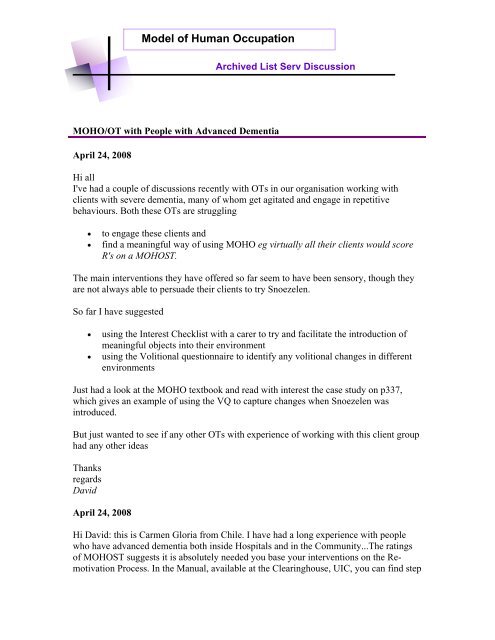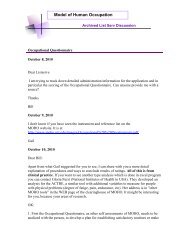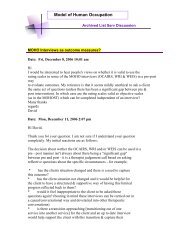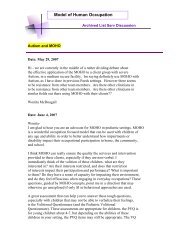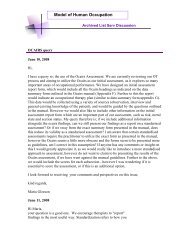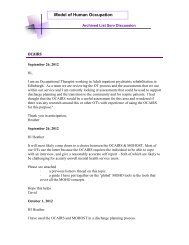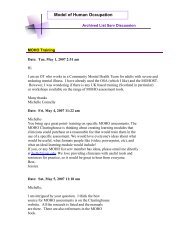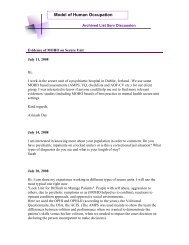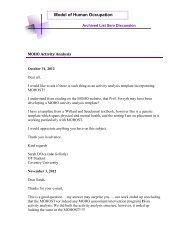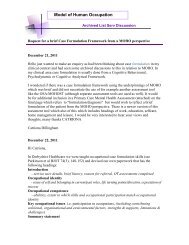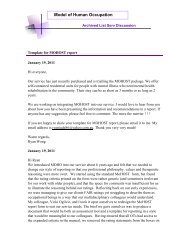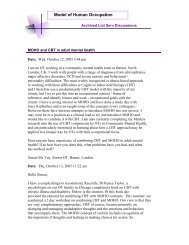MOHO/OT with People
MOHO/OT with People
MOHO/OT with People
You also want an ePaper? Increase the reach of your titles
YUMPU automatically turns print PDFs into web optimized ePapers that Google loves.
Model of Human OccupationArchived List Serv Discussion<strong>MOHO</strong>/<strong>OT</strong> <strong>with</strong> <strong>People</strong> <strong>with</strong> Advanced DementiaApril 24, 2008Hi allI've had a couple of discussions recently <strong>with</strong> <strong>OT</strong>s in our organisation working <strong>with</strong>clients <strong>with</strong> severe dementia, many of whom get agitated and engage in repetitivebehaviours. Both these <strong>OT</strong>s are struggling• to engage these clients and• find a meaningful way of using <strong>MOHO</strong> eg virtually all their clients would scoreR's on a <strong>MOHO</strong>ST.The main interventions they have offered so far seem to have been sensory, though theyare not always able to persuade their clients to try Snoezelen.So far I have suggested• using the Interest Checklist <strong>with</strong> a carer to try and facilitate the introduction ofmeaningful objects into their environment• using the Volitional questionnaire to identify any volitional changes in differentenvironmentsJust had a look at the <strong>MOHO</strong> textbook and read <strong>with</strong> interest the case study on p337,which gives an example of using the VQ to capture changes when Snoezelen wasintroduced.But just wanted to see if any other <strong>OT</strong>s <strong>with</strong> experience of working <strong>with</strong> this client grouphad any other ideasThanksregardsDavidApril 24, 2008Hi David: this is Carmen Gloria from Chile. I have had a long experience <strong>with</strong> peoplewho have advanced dementia both inside Hospitals and in the Community...The ratingsof <strong>MOHO</strong>ST suggests it is absolutely needed you base your interventions on the RemotivationProcess. In the Manual, available at the Clearinghouse, UIC, you can find step
y step in which tou learn to center your intervention in a holistic way and the way youhave to go about volition.Usually <strong>OT</strong>s are used to work <strong>with</strong> people that already engages in activities, and theserealities, are a challenge that teaches us to focus in each person’s reality (environment,performance, own occupational history) and if we take in consideration these variables,using the VQ, you can be guided to go at their pace and also feel confident about whatyou are doing and about the outcomes you see, which are relevant. Sometimes, the key isjust how to arrange the physical environment to give meaning to people to give backmeaning to their lives. Some others include more intervention.<strong>People</strong> have volition at different levels according to their capacities and emotionalrealities. Some of them can live the process experiencing and choosing, others onlyfeeling the experience of the environment, others living the experience, interpretation,anticipation and choosing. In this group of people we usually find the first two situations,so we, as occupational therapists need to understand those processes.The VQ and re-motivation process (see Exploration Module for your current question)are key both for people we serve and for therapists confidence about evidence basedpractice.My experience in Psycho geriatrics, have been very gratifying and all staff and treatmentteams have been able to see the difference, plus nursing and <strong>OT</strong> support staff were verysatisfied when seeing progress through learning to see volitional indicators in acontinuum, little by little. The <strong>OT</strong> guides the process, does it, and evaluates, other staffcan learn the VQ and give information and can be key in re-motivation process.Ask more, if you need. I can write examples of Programs and individuals..I am glad you brought this up!!Carmen Gloria de las Heras, MS, <strong>OT</strong>RApril 24, 2008Hi David,It's an interesting problem, and one we're trying to get to grips <strong>with</strong> here in Newcastle.Recent service changes have meant that hospital admission is avoided for all but the mostseverely-impaired people <strong>with</strong> dementia, effectively changing the assessment ward into achallenging behaviour service.Before these changes we'd tried to establish MoHOST as a baseline assessment tool inthe service, but, as in your service, found that people tend to "bottom out". The VQseemed a possibility, but scoring was also an issue <strong>with</strong> this tool. My current thinking isthat, rather than concerning ourselves <strong>with</strong> acquiring scores, we should use the structureof MoHOST to complile an Occupational Profile of our clients - we needn't rate it, butcan be sure that we're considering all aspects of the individual's past and present
occupational identity. Of course, the beauty of the MoHOST structure is that it allowsinformation gathering from a variety of sources, including carers who may be our onlyavenue for tapping into the client's former interests, choices, values and patterns.Even then, I suspect that it may prove difficult to engage many service users, so we endup <strong>with</strong> a great deal of information, but are still unable to effect change.It's a controversial viewpoint, but dare I suggest that it is sensitive nursing rather thanoccupational therapy that these people need, and that resources might be better targettedtowards the community and early intervention? I'm not suggesting that they don't haveunderlying occupational needs, but that the nature of their condition doesn't allow forthese to be addressed. Is there any research evidence to support the use of <strong>OT</strong> <strong>with</strong>clients <strong>with</strong> the most severe presentations of dementia? Unfortunately, the recentNational Audit into violence on inpatient wards proposed that more meaningful activitywas required to reduce levels of aggression, so we might find it a challenge to be allowedto re-focus our skills!Finally - and I'd love to hear others' views on this - is Snoezlen an occupational therapyintervention? It seems to me that snoezlen is something that older people who cannotexpress their preferences are subjected to, rather than a meaningful activity they chooseto engage in, so they are merely recipients of, rather than participants in a therapeuticprocess. Discuss!!!ChrisApril 24, 2008Hi David,.... and I promised you that I would try not to respond to so many emails in future! I'll bebrief though: I suggest using the OPHI 2 by proxy <strong>with</strong> carers and the RemotivationProcess alongside the Volitional Questionnaire.SueApril 24, 2008Yes, In the Re-motivation Manual the OPHI-II is included as a proxy <strong>with</strong> carers whenneeded.carmen gloriaApril 24, 2008Hi everyone,This is my favorite patient group. I use <strong>MOHO</strong>ST for the initial evaluation. The best
thing you can do though is familiarize yourself <strong>with</strong> Naomi Feil's workon Validation Therapy. Feil is a social worker that grew up in a nursing home. Sheidentified validation therapy as a method to help people become connectedand remain happy until they die. The belief is that validation therapy helps people cometo terms <strong>with</strong> their life - to get through the resolution stage of aging. The reason <strong>MOHO</strong>works so well <strong>with</strong> this theory is that much of the behavior we see is ground in people'spast occupations. According to Feil, people do not experience time as linear but moveback and forth through time. They return to times in their life that are emotion laden.The best therapy you can provide is the opportunity to engage in activities that make upthose meaningful occupations. This requires time spent <strong>with</strong> family to determine whatthat person did in their life, good and bad. We have spent time getting bottles from thepharmacy, along <strong>with</strong> a lab coat for a recent patient <strong>with</strong> Pick's that had worked all hislife as a pharmacist. A few Skittles and M & M's and he was engaged.An interest checklist is difficult <strong>with</strong> people in advanced stage dementia but having thefamily do it, then bringing out things to try <strong>with</strong> the patient will allow you to find whatyou need to know.As far as the sensory goes, there are definitely things you need to know about the changesin sensory. Having a good working knowledge of the sensory modulation theory reallydoes help. I think some people have sensory defensiveness but it is really hard to know ifthat is a result of the dementia process or was always there and because of the disease,they are no longer able to modulate or adapt. We sometimes forget that people <strong>with</strong>dementia may have had learning disabilities, sensory modulation difficulties and othersuch issues long before they developed the symptoms of dementia. Tina Champagne hasa wonderful book available on her website that ishelpful <strong>with</strong> this. The research is still out on Snoezelen. Tina's website iswww.otinovations.com. You do not need to spend thousands of dollars toprovide good sensory modulation activities <strong>with</strong> people who have dementia Read up onBarry Reisberg's work on Retro genesis. This theory says that people regress cognitivelyin the same general pattern and time frame that babies develop. I concur - after 5 years ofpaying close attention. I can tell you what a person can and cannot do by watching themeat a meal. This is really helpful information when you need to know what aperson is able to do as far as self-care. More importantly, this theory really helps <strong>with</strong>understanding what is appropriate activity for a person at that stage of the disease.If you were to ask a group of people what is most meaningful in their life (I do this <strong>with</strong>patients, professionals, and family), they will tell you all of the roles on the rolechecklist. This has become a fun little experiment for me the last 5 years and hasremained consistent <strong>with</strong> every group. The importance of this to me is that in certainliving facilities,opportunities to engage in the activities related to these meaningful roles are N<strong>OT</strong>available. Using a client centered approach, one of the best things youcan do <strong>with</strong> this population is to create opportunity to participate in activities that makeup meaningful roles. Care of children, work related tasks, etc. We have gotten Carpentertools, when appropriate. We have allowed people to lead groups or activities, etc.
Obviously <strong>with</strong> guidance and adaptation. The possibilities are endless here.Another great resource for this population is Carl Helen’s book "Alzheimer's Disease:Activity Focused Care." She has a chapter on creating "Life Storybooks" These aresimple scrap books that highlight people’s lives. These books have all sorts of usesincluding providing occupational history information to others who come in contact <strong>with</strong>this person. The books are made to go <strong>with</strong> people to different places (the hospital, thedoctor's office). Gives people an idea of who the person was throughout their life, thewhole picture. Also allows people to ask the person about the items in the book. Keepspeople connected, and celebrates a lifetime of occupational accomplishments.I think using <strong>MOHO</strong> <strong>with</strong> this population (the theory, not a bunch of evals) makes a bigdifference in how therapists approach them and engage them. I see huge difference inagitation when I understand what the behavior means and can react accordingly. This isa wonderful group of people to work <strong>with</strong>, especially if you enjoy problem solving as partof therapy.Lisa Mahaffey M.S. <strong>OT</strong>R/LApril 27, 2008Hello everyone,As Dr. Kielhofner states, I recently completed my dissertation research in which Iexamined the experience of volition for persons <strong>with</strong> moderate dementia in aphenomenological study. I strongly agree <strong>with</strong> the points addressed in this discussionthus far, and in addition to the excellent resources mentioned thus far, I would also directthose interested in this area to explore further the concepts of person-centered care by Dr.Thomas Kitwood, from the UK, and Tessa Perrin, <strong>OT</strong> from the UK who has applied theseconcepts to <strong>OT</strong> approaches for persons <strong>with</strong> dementia.The person-centered care movement began in the UK (stemming from Kitwood's work),and is growing as a standard of practice in the US (See Alzheimer Association-US-Recommended Standards of Practice for Dementia Care), The concepts of personcenteredcare are very congruent <strong>with</strong> <strong>MOHO</strong>, and as such, provide ways tocommunicate <strong>with</strong> other dementia care team members.My exploration of volition in this population revealed the pervasive significance of thesocial environment in the expression and experience of volition, which can be captured inthe VQ. This was a main theme in my research, and highlights the transpersonal natureof volition. This is particularly true when we look at how others recognize, and thenrespond (or not) to a person’s volitional behavior. Unfortunately, many caregivers mayoften assume low to no motivation (volition) for these individuals, and this can lead tolack of recognition of preferences, <strong>with</strong> consequences of sensory deprivation and excessdisabilities as the limited opportunities are provided for the individual to engage in theirenvironment.
Additionally, the participants in my study demonstrated a great deal of variability in theirvolition expression, and volitional behaviors (verbal and non-verbal) were often subtleand contradictory. This adds more challenges to caregivers who may not recognizevolitional behavior, and/or have adequate skills to respond. Another fascinating findingin my study was that caregivers often do not associate “problem” or “challenging”behaviors as expressions of volition. For example, a person who is “hoarding” (framedas “collecting” behavior in person-centered care) is often creating occupation in anenvironment <strong>with</strong> limited supports for meaningful engagement.Another point that arose in my research is the need to further examine the hierarchy ofvolition (exploration, competence, and achievement) and how it applies to theexperiences of these individuals. For several participants in my study, the volitionalnarrative was often more reflective of strengths in higher areas (ie, competence) whileexhibiting some challenges in exploration. Obviously environmental factors, particularlysocial, affected this social construction.This highlights some of the major points. I have attached a handout from the postersession I gave at A<strong>OT</strong>A last year. I am currently writing these findings into an article forpublication. I’d love to dialogue more <strong>with</strong> everyone working <strong>with</strong> this population,particularly those using the VQ/Remotivation Process, as I feel it has a great deal ofpotential to help us provide clinically relevant interventions to better meet the needs ofpersons <strong>with</strong> dementia.Thanks!ChristineChristine Raber, PhD, <strong>OT</strong>R/LApril 25, 2008Snoezelen did not originate as an <strong>OT</strong> intervention, but sensory integrationis anddid recently <strong>with</strong> advances in brain imaging, there is now some evidencefor theinterventions of Jean A Ayres from applied neuroscience.In Cornwall, w have a sensory room and a portable sensory cart, the BeSMaRT Cart, which we use <strong>with</strong> great success <strong>with</strong> clients <strong>with</strong> a range of mental health difficulties, including those who self harm and those <strong>with</strong> dementia......In the clients <strong>with</strong> dementia, supporting vestibular, tactile and proprioceptive functionhelps to support and maintain sense of body awareness, balance and mobility, andsensory activities support cognitive function, (nothing you know doesn't have to go inthrough one of your senses before it is processed by the brain and then we respond).(Recent research shows cognitive stimulation is as effective, if not more so in preservingfunction that cognitive enhancers - this was cited in a recent copy of BA<strong>OT</strong> Journal, buthaven't the copy to hand to cite the reference right at this moment).
I think it is powerful to reflect on research about sensory deprivation -If you remove sensory input from people (well people) they quickly become unwelleven psychotic, dementia can 'starve' the brains access to it's input of sensoryinformation and the challenging behaviours that are often seen from olderadults can be clearly understood using SI as a model - i.e. the behaviours are a resultof a little or misinformed responses to input from the body, the world aroundthem and other people - definitely a not just a role for nurses.....<strong>MOHO</strong> wouldexplore how decreased access to the ability to process information <strong>with</strong>in theneurological system affects occupational performance. We use the ACIS and VQ <strong>with</strong>this client group during and after sessions, as the clients tend to become calmer,more aware of their own body, the environment and other, all of which promote andsupport their ability to engage in occupational activities, be that better performancewalking, being able to make eye contact and respond to their husband's handsqueeze, or merely be less agitated and scared and therefore able to get much neededsleep.We are passionate about supporting older adults in this way and have hadsome super results <strong>with</strong> a decrease in challenging behaviours and even <strong>with</strong> someone<strong>with</strong> severe diffuce end stage dementia, <strong>with</strong> an SI programme were able to increaseproprioceptive and vestibular activities, these reduced the need for gettingproprioceptive and vestibular input head banging and as these help usorientate in space dramatically reduced the crashing into things and other elderlyresidents - the 'behaviours' that caused the admission gone, it was enough to returnsomeone to a private residential home instead of hospital unit......Also some sensory interventions can be taught to relatives, something theycan do when going out in a chair or sharing a cup of tea is no longer possible,it helps maintain their sense of involvedness <strong>with</strong> their loved one <strong>with</strong> somethingthat can be calming and soothing right at the end.I will load a PowerPoint presentation onto the Sensory Project websiteabout sensory approaches <strong>with</strong> the elderly for you all this weekend, as well as a link to anarticle by Winnie Dunn, one of the author's of the Adult/AdolescentSensory Profile. (I have given up trying to email PowerPoint files to individuals becauseof overly robust hospital mail scanners thinking any name cited is patientidntifiable data and spamming them or sending warnings to me for breakingconfidentiality, and the frustration it causes everyone including all the failed deliverieswhich carshed my system, so no longer mail out to individuals - Sorry)see below for more about SnoezlenKath Smith>From Wwikipaedie re Snoezelen History:
Snoezelen or controlled multisensory stimulation is used for people <strong>with</strong>mentaldisabilities, and involves exposing them to a soothing and stimulatingenvironment,the "snoezelen room". These rooms are specially designed to deliverstimuli tovarious senses, using lighting effects, color, sounds, music, scents, etc.Thecombination of different materials on a wall may be explored using tactilesenses,and the floor may be adjusted to stimulate the sense of balance.Originally developed in the Netherlands in the 1970s, snoezelen rooms havebeenestablished in institutions all over the world and are especially commonin Germany,where more than 1200 exist. The term "snoezelen" (pronounced like"SNOOzelen") is aneologism formed from the Dutch "snuffelen" (to sniff, to snuffle) and"doezelen"(to doze, to snooze).Ideally, Snoezelen is a non-directive therapy and can be staged to provide amulti-sensory experience or single sensory focus, simply by adapting thelighting,atmosphere, sounds, and textures to the specific needs of the client atthe time ofuse. There is no formal focus on therapeutic outcome - the focus is toassist usersto gain the maximum pleasure from the activity in which they and theenabler areinvolved. An advantage of Snoezelen is that it does not rely on verbalcommunicationand may be beneficial for people <strong>with</strong> profound autism, as it may providestimulationfor those who would otherwise be almost impossible to reach.Snoezelen is used for people <strong>with</strong> autism and other developmentaldisabilities,dementia, and brain injury. However, research on the benefits of treatment isscarce, <strong>with</strong> variable study designs.[1][2]A small research study carried out in Brussels compared the behavior ofnine adultclients <strong>with</strong> profound autism in both classroom and Snoezelen settings. Though
individual results varied, the study claimed a 50% reduction in distress andstereotypical behavior, and seventy-five percent less aggression andself-injury inthe Snoezelen environment.April 27, 2008Dear Kath-Thank you for demonstrating how <strong>MOHO</strong> can be used in combination <strong>with</strong> otherapproaches to practice. As a school therapist working <strong>with</strong> children <strong>with</strong>multiple disabilities we used Snoozelen because children were highlyinterested, and the accessibility of the equipment really gave them asense of efficacy and capacity to control and interact <strong>with</strong> theirenvironment. Using the ACIS and VQ <strong>with</strong> Snoozelen (and other interactive,multi-sensory environments) is a great way to document the impact theseenvironments have on volition and interaction.Best-Jessica


